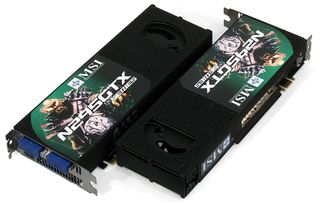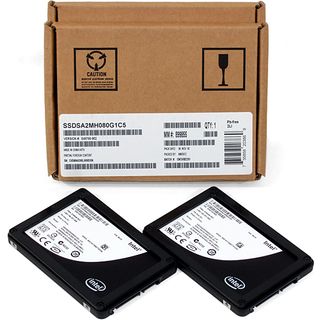System Builder Marathon: The $5,000 Extreme PC
Graphics And Storage

Graphics: Two MSI GeForce GTX 295 Cards In SLI
Three weeks ago, Nvidia proved to us that while two graphics processors are great, four can be better. We concluded that the only reason to buy more than one GTX 295 was for bragging rights, but with so much invested in the rest of our system, we really wanted those bragging rights.


Read Customer Reviews of MSI's GeForce GTX 295 1,792 MB
A Newegg special on the MSI N295GTX-M2D1792 was enough to seal the deal for us, but a recent price drop for another brand could have made the choice more difficult. With two brands of reference-design cards now available for the same price, our selection process would hinge on the level of the warranty and service if we were to make the purchase today.
System Drives: Two Intel X25-M 80 GB SSDs In RAID 0
One of the most repeated complaints from our previous $2,500 PC was its use of a 2.0 TB RAID 5 array consisting of three 1 TB drives. We had chosen RAID 5 for its redundancy and limited loss of capacity, but questions concerning its performance and overhead were only answered after testing it. The integrated ICH10R controller extracted minimal overhead from our CPU, but the tradeoff was limited transfer performance. Our hopes of something “in the middle” quickly vanished when we saw the PCMark performance scores.
Our budget increase would have left room for a hardware RAID card to boost RAID 5 performance, but many readers wanted to see a build based on SSDs. Using top-model SSDs would again price us out of the hardware RAID controller market, but SSD technology’s resistance to catastrophic failure allowed us to scale back to a performance mode that didn’t require hardware control. Non-redundant RAID 0 also receives little benefit from hardware RAID.
Stay on the Cutting Edge
Join the experts who read Tom's Hardware for the inside track on enthusiast PC tech news — and have for over 25 years. We'll send breaking news and in-depth reviews of CPUs, GPUs, AI, maker hardware and more straight to your inbox.


Read Customer Reviews of Intel's X25-M 80 GB SSD
Super-fast single-level cell (SLC) drives are tiny and we wanted enough space to store a few programs for faster launch times. Multi-level cell (MLC) drives, on the other hand, are larger and cheaper, but are typically slower. Intel got around the “slow MLC” problem via parallelism in its 10-channel X25-M drives.
We knew that we’d need at least 128 GB and a 160 GB X25-M would have provided the capacity we needed without completely blowing our budget. Fortunately, each Intel X25-M 80 GB drive costs half as much, allowing us to seek the performance benefits that a RAID controller’s Level 0 mode is known for.
For those who can’t remember RAID controller-level details, Level 0 mode divides data across two drives and the array size equals the total capacity of both drives. (Actually, since RAID means redundant array of independent disks, a non-redundant Level 0 mode can’t logically be called RAID.)
The 80 GB X25-M dropped by an amazing $120 per drive between the day we ordered components and the day we finished testing. That $240 difference is the primary reason our budget wasn’t used up by the addition of other performance gear.
Storage Drive: Seagate Barracuda 7200.11 1.5 TB
Any high-end machine is going to have capabilities beyond gaming and those capabilities place higher demands on storage. A super-fast Core i7 processor and 6 GB of RAM should make our $5,000 PC ideal for heavy tasks such as 3D rendering and video editing and the accumulation of related files can quickly increase storage needs by hundreds of gigabytes. We chose Seagate’s Barracuda 7200.11 1.5 TB hard disk drive as a quick-and-easy way to add mass storage without slowing down our system.


Read Customer Reviews of Seagate's 1.5 TB Barracuda 7200.11
A single part number ST31500341AS doesn’t cost much, but we had already devoted the majority of our budget to performance hardware. Subsequent price drops will allow buyers to add a second 1.5 TB drive in RAID 1 for redundancy, without exceeding a $5,000 limit.
-
xx12amanxx Nice article!Reply
I wish i could own a rig like that,but it would be that or a 383 stroker for the F-body..lol I can dream cant I? -
Crashman xx12amanxxNice article!I wish i could own a rig like that,but it would be that or a 383 stroker for the F-body..lol I can dream cant I?Reply
383 strokers are for copycats. Basically, too many bad 400 blocks and people found a cheap way to re-use the cranks to make their 350's bigger. If you have THIS kind of money, you'd might as well go BIG BORE too. Maybe a bowtie block? At any rate, you'll win more races with a real 400 (or larger custom size) so long as the block is good. -
one-shot It is interesting to note on Page 14. On the Sandra XII Multimedia test the Core i7 965 @ 4.2GHz scored 486,971, while the i7 920 @ 4.0GHz scored 386,867. The difference was 200MHz and made such a large difference. Did the Intel SSDs influence such a large gain in performance or the DDR3 @ 1800MHz or perhaps a combination of both?Reply -
Crashman Reply9469314 said:It is interesting to note on Page 14. On the Sandra XII Multimedia test the Core i7 965 @ 4.2GHz scored 486,971, while the i7 920 @ 4.0GHz scored 386,867. The difference was 200MHz and made such a large difference. Did the Intel SSDs influence such a large gain in performance or the DDR3 @ 1800MHz or perhaps a combination of both?
The 965 has a higher-bandwidth QPI link, so it should be good for boosting at least a few synthetic scores. -
gim159 BAH!! Why is it always Intel? Only Servers and people that wish they MAC should use Intel stuffs.. Who else is going to use all of it's features? Not gamers, that is for sure!! Like a gamer is going to spend the extra $$ for ECC memory and not spend it on more important stuff like a GC or a great board. That and an economy minded PC buyer will go AMD anytime, more bang for the buck...Reply
Also, Ati is better a better card, for linking I mean. The support may be crap, but it is usually worth it to get them! 4850 X2, Water cool one and watch the clock go through the roof! -
xx12amanxx Intel is the fastest thats why...This is supposed to be an uber rig.Reply
Ya crashman thats the problem i dont have that kind of money..lol A fresh stock rebuild bolt on's and spray will have to hold me off until better times! -
gim159 Yeah, Optimize the heck out of it and take all of the unnecessary stuff out.. Probably 4 sec boot, Awesome!Reply -
Crashman xx12amanxxIntel is the fastest thats why...This is supposed to be an uber rig.Ya crashman thats the problem i dont have that kind of money..lol A fresh stock rebuild bolt on's and spray will have to hold me off until better times!Reply
I spec'd out a friend's 406 C.I. mouse a few years ago and he got through under $4500 with aluminum heads and a roller cam!
Most Popular


